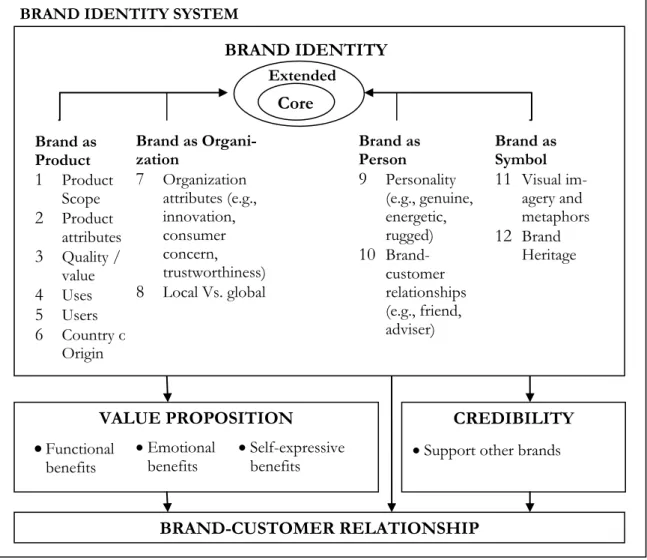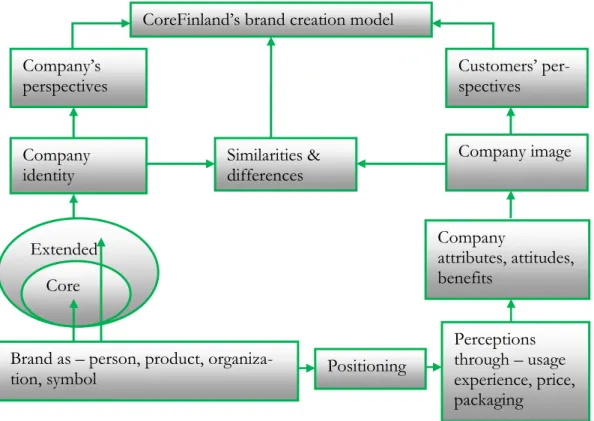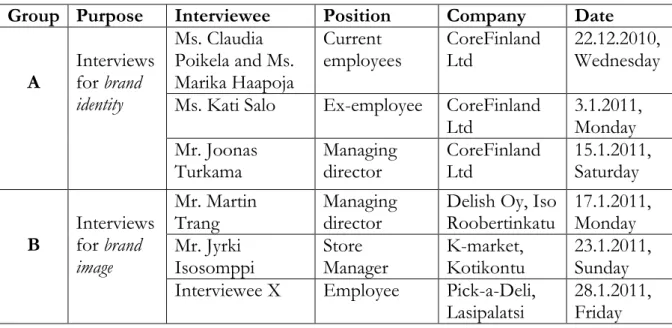This broader milestone is achieved by examining the case company's brand identity and brand image issues. Furthermore, the research suggests a suitable brand identity by considering customer perceptions and the company objectives.
Background to the thesis
Building appropriate brand identity helps a company tell its customers what its business is about, what its missions and visions are, in what ways it is different from competitors, what promises it can make and deliver, why customers can trust it, etc. In this context, it is important to know the current corporate image among b-to-b customers, which could be referred to suggest appropriate brand identity.
Objectives and research questions
The presumption is that there is already some kind of brand image of CoreFinland among its business customers. In this, the study seeks to find out CoreFinland's current brand identity and image; and later it makes comparative study to determine where the lack of their (identity and image) comparison exists.
Research limitations
This milestone is achieved by obtaining answers to various research questions in a b-to-b context.
CoreFinland Ltd (CFL)
The reputation of the company is reflected in the way it promises the customers and keeps the promises such as: delivery, after sales service, etc. All these internal and external elements of the company should be taken into account in such a way that they all get what they want.
B-to-b brand relevance
Meeting the needs of the stakeholders is a daunting task for the companies, but those who succeed can lead the stakeholders to generate positive feelings towards them and eventually develop a positive image. The image that a company's customers have perceived is solely their subjective activities; nothing can stop customers from making their image about the company, but the image is directly related to the identity, therefore the identity must be strong.
Power of b-to-b branding
The basic concept of brand identity is that it is a set of characteristics that identify a brand. De Chernatony (2002, in Bivainiene) argues that brand identity is the essence of brand individuality; and it strengthens the brand.
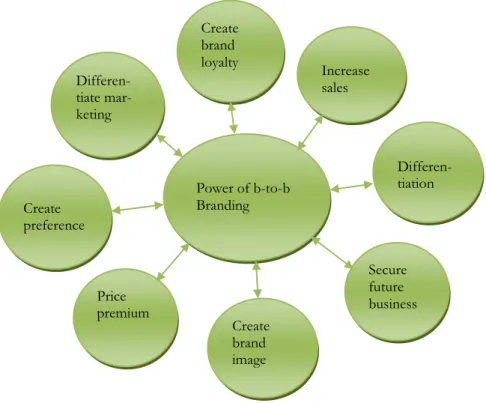
Brand identity system by Aaker
This uniqueness of brand identity can also be seen through Gad's brand code concept, where brand code equates to business DNA that manifests unique set of characteristics of the brand (Gad 2001, 16). Brand identity must reflect the benefits and consumer expectations, which helps to respond to the changes effectively and adequately (Bivainiene 2010, 412).
Brand identity perspectives
- Brand as product
- Brand as organization
- Brand as person
- Brand as symbol
The brand identity should be such that when the product class is mentioned, customers should be able to associate that class with the brand. It shows its desire to feel the future, longevity and intention to invest in the brand.
Identity structure
Brand image is the consumer's perception of the brand as reflected in the brand associations stored in the consumer's memory. Building a brand image is a marketing effort, for example, marketing campaigns/programs will help create strong, favorable and unique brand associations in the minds of customers.
Corporate brand image
Knowing the brand image (how customers and others perceive the brand) provides useful and even necessary background information when developing a brand identity. So the brand image is the main, but not the only component of the brand identity, as Aaker mentions in "Brand Creation". identity is more than figuring out what customers say they want (customer brand image). While identity is an internal audit, brand image is an external audit, i.e. trying to find out how a particular brand can appeal to the public. Holistic image is simply the organization's manipulation and imposition of messages on the public through the media image, while others include the audience's perspectives and believe that the organization does not control them.
Brand image formation
According to Keller, product-related attributes are defined as the ingredients necessary to perform the product or service function that the consumer is looking for. Non-product attributes are defined as external aspects of the product or service related to its purchase or consumption. It's about consumers' beliefs about the product or service and the evaluation of that belief as how good or how bad the brand is for them.
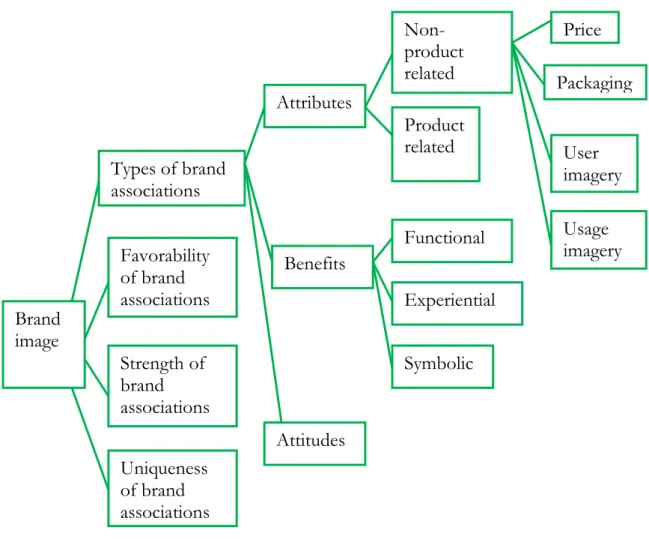
Image building process
Similarly, the company characteristics are also the composite factors of product, person, organization and symbol. In this compilation, the company identity as a product, person, organization and symbol is considered more in b-to-b brand context. The company perspective' in this model examines important identity factors or dimensions that CoreFinland wants to spread among its business customers.
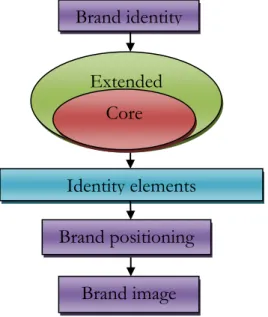
Research method
Interviews
The interviews were conducted in different phases, each of which varied according to time, space and situations, but keeping in mind the research objective. A preliminary interview was conducted with the director (16/09/10) in order to establish a good foundation for the research, identify problem areas of the company and draft details of the interviewees. This interview was extremely important for the further work on this project, which gave a clear picture of the current state of the company, the acute problem the company is facing, and in what way he (med.) was interested in allowing us to carry out the study .
Data analysis method
Challanges in data collection
As KESKO is one of CoreFinland's biggest customers, it was really important to interview any staff there. They tried to make contact with them by all available means; however, their tight schedule made it nearly impossible to get the right person from the right department at the right time. But in the end, it was decided to remove KESKO from the list of respondents, because its answer would not significantly add new insights and therefore the findings would remain the same.
Validity and reliability
Validity
Since the research was about "creating brand identity" for the case company by considering brand image, the most relevant and detailed theory was extracted from Aaker's Identity System. It refers to the extent to which the results from a study can be generalized to other environments (Gauri & Grønhaug 2005, 218). To some extent, the results can be generalized, but they cannot hold for all environments because the nature of the research is a case study of a particular company.
Reliability
Construct validity refers to the extent to which your measurement questions actually measure the presence of those constructs you intended them to measure (Saunders et al. The bias in the interviews was avoided by sticking strictly to the interview questionnaire. Some of the respondents sounded. to to be more faithful to the case company, those biases are nonetheless minimized by every possible distraction, probing question, etc.
CoreFinland‟s brand identity
Core identity
Professional and friendly customer service is the result of professional and highly motivated employees who, according to Turkama, take very good care of customers. According to Turkama, the name "CoreFinland" portrays the idea that "CoreFinland is the company that handles the core businesses of related companies (customers) in Finland," which is why the company exists. The company has also been repeatedly mentioned as being environmentally friendly, which is shown by making packaging harmless to the environment and saving energy by printing less and working more online.
CoreFinland‟s brand identity perspectives
One of the respondents also emphasized that the products have attractive and environmentally friendly packaging. It was found that the respondents knew the purpose of the organization and its purpose, although some differences were noted in the responses. It was even stated that the company is small and the values have not yet crystallized.
CoreFinland‟s brand image
General brand image
It is highly recommended that the company use CoreFinland instead of CFL, including within the organization, as CoreFinland really represents the meaning and purpose of the brand. Although the company has its own logo, this is not communicated through its products. In general, CoreFinland's business customers have faced challenges with all suppliers on issues such as minimum quantity requirements, incorrect quantities and prices, delivery and expiration dates of products.
CoreFinland‟s brand image perspectives
One of the respondents got to know the company through the sales agent, which implies that sales agents can also be a good tool in this regard. However, the company's impression turns out to be positive among direct customers due to its product quality and outstanding customer relations. Direct customers personified the company in various ways such as flexible, youthful, motivated, proactive, dedicated, hardworking, positive, passionate, etc.
CoreFinland‟s identity versus image
Therefore, the company should continue to focus on the same personal identity in the future. Direct buyers believe that the company still does not have a wider range of products compared to their other suppliers (CoreFinland's competitors). Fast service is the main functional advantage that the company provides to customers; and customers also consider fast service to be a benefit they receive from CoreFinland.
Suggestions for CoreFinland
The entire study is based on the devised model (see figure 5) and the brand identity system (see chapter 3.1), where the company perspectives are compared with the customer perspective and the desired identity is created (see chapter 8.1).
Further research
Questionnaires for semi-structured interviews
How do you see CoreFinland in relation to other of your business partners in the same product areas. Do you think it is a health-oriented, environmentally friendly, charitable, profit-oriented organization or possibly Would you like to do business with CoreFinland in the future, what areas do you think it needs to improve.
Interview responses for brand identity (Group A)
The core business is salting healthy products in Finland, making them popular with marketing and sales. Weekly employee management meetings to stay committed to CoreFinland values and culture, a picnic to motivate employees to.,. Young, dynamic, friendly, knowledgeable, open in many directions, risky Social class every social class middle class,.
Interview responses for brand image (Group B)
I think packaging is environmentally friendly; products sound good for health, profit is always more reason. The price is not really low, we like high-priced products, packaging and appearance is good.
